人教版英语九年级全册Unit9 SectionB(3a-3b)优质课教案
- 格式:doc
- 大小:33.00 KB
- 文档页数:3
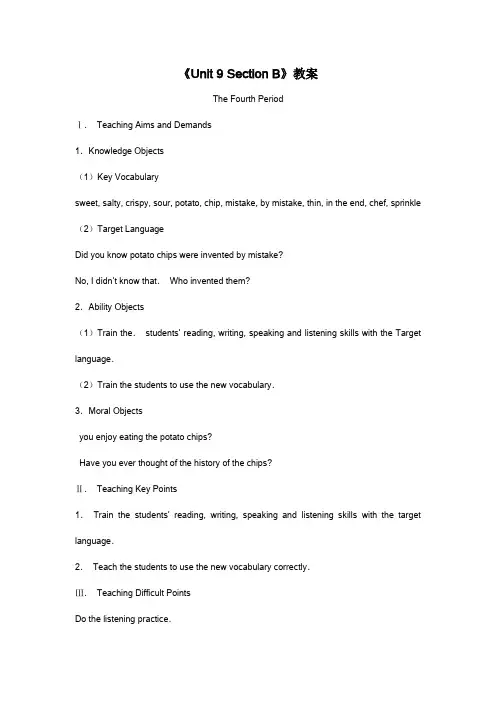
《Unit 9 Section B》教案The Fourth PeriodⅠ.Teaching Aims and Demands1.Knowledge Objects(1)Key Vocabularysweet, salty, crispy, sour, potato, chip, mistake, by mistake, thin, in the end, chef, sprinkle (2)Target LanguageDid you know potato chips were invented by mistake?No, I didn’t know that.Who invented them?2.Ability Objects(1)Train the.students’ reading, writing, speaking and listening skills with the Target language.(2)Train the students to use the new vocabulary.3.Moral Objectsyou enjoy eating the potato chips?Have you ever thought of the history of the chips?Ⅱ.Teaching Key Points1.Train the students’reading, writing, speaking and listening skills with the target language.2.Teach the students to use the new vocabulary correctly.Ⅲ.Teaching Difficult PointsDo the listening practice.Ⅳ.Teaching Methods1.Listening2.PairworkⅤ.Teaching Aids1.A tape recorder2.Some bags of potato chips.Ⅵ.Teaching ProceduresStep ⅠRevision1.Check the homework by asking some children to read their conversations to the class.2.Ask some questions about the inventions.For example, what do you think is the most helpful invention?3.Dictate the words below:bulb light, microwave oven, island.Step Ⅱ1aThis activity introduces new vocabulary.First, show the new vocabulary on the screen by a projector.Point to each word on the screen and teach the students to read one by one.Do it several times until the children can read the new words fluently.Read the instructions to the class.Point out the four adjectives on the left.Have them read the four words together.Then ask some different students to read them.Then ask the students to try to tell the meaning of each word in English in their own words, or give some examples of foods that show what each word means.For example, help the students explain it like this:Sweet is used for describing something that tastes like sugar or honey.It’s the opposite word of sour.After that, ask the Students to tell the names of the foods in the pictures potato chips, lemon, ice cream, tea.Please choose the words in the box to describe how the food in the pictures tastes.Write them under the correct pictures.Note that some pictures have more than one word.Tell them to see the example answer before writing.After a while, check the answers by asking several students to read their answers to the class.Answers:potato chips: crispy, saltylemon: sourice cream: sweettea: sweetOptional activityBring some foods that taste sweet, crispy, salty and sour to the class.Have some students, one at a time, taste little pieces of each food.Then report how the foods taste to the class with the new adjectives, sweet, crispy, salty and sour.Students may one more than one word to describe some foods.Step Ⅲ1bThis activity provides practice using the new vocabulary and writing familiar words.Ask the students to read the instructions together.Point out the four taste words.Then point to the sample answer given.Please write the name of a different food after each word.You can write the name of any food you know in the blank.Can you think of other sweet food now? (apple, orange, etc.)Ask the students to complete the activity on their own.After they all finish writing, ask some students to read their answers to the class.Check the answers with the whole class.Answers:Answers will vary but may include:sweet: apple, orange juice, soda, cake, honeycrispy: french fries, salad, lettucesalty: french fries, olives, pepperoni, pizza, popcornsour: pickle, grapefruitStep Ⅳ2aThis activity gives students practice understanding the target language in spoken conversation.Let the students read the instructions together.Be sure that they all know what to do.Call the students’ attention to the six sentences in the box.Ask six different students to read them and do some explanation in their own words on each sentence.After that, get the students to guess what they will hear about.Maybe someone can answer like this, may listen to something about the potato chips.Show some bags of potato chips them or even let some children taste the chips.Yes.You’ll hear a story about the invention of the potato chips.Please look at the first sentence now.It is a sample answer given.The statement is true so the letter T is circled.Then play the recording first.Students only listen.Play the recording again.Ask the children to listen and circle T for true or F for false.Check the answers with the whole class.1.T 2.F 3.T 4.F 5.F 6.TTapescriptBoy 1: Hey, did you know that potato chips were invented by mistake?Boy 2: Really? What do you mean?Boy 1: Well, here on the bag it says that they were invented by a chef called George Crum.Boy 2: When was that?Boy 1: Oh, it was way back in 1853.Boy 2: So, why was it an accident?Boy 1: Well, one day a customer in the restaurant where George worked sent back his plate of fried potatoes because he said they were cut too thick.Boy 2: So what happened?Boy 1: Well, George was in a bad mood, so he cut the potatoes really, really thin, and he cooked them for a long time until they were crispy.And he sprinkled lots of salt on them so they were really salty.He thought the customer would hate them.Boy 2: And?Boy 1: And the customer loved them and asked for more.He told the other customers about them, and soon everyone was ordering thinly-sliced, crispy, salty potato chips.Boy 2:And we’re still eating them today.What a cool story!Boy 1: Yeah.This activity gives students practice in understanding and writing the target language.Get the students to read the instructions together.Point to the blanks in the sentences in the story and tell them to complete the sentences while they are listening.You’ll listen to the same recording again.Before I play the recording, please try to give the answers by memory, or just by guessing.It doesn’t matter whether your answers are right or wrong.After a while, have the students get ready to listen.Play the recording again.Ask the students to fill in the blanks with the words they hear.Get several students to share their answers with the class.Correct the answers with the whole class.Answers1.Did you know 2.were invented3.1853 4.were crispy 5.really saltyStepⅥ2cThis activity provides guided oral practice using the target language.Play the recording of the history of chips again.Pause for the students to repeat after it.Get the students to read after the tape at least twice.Tell them to try their best to copy the pronunciation of the recording.Read the instructions to the class.Tell them that they will role-play the conversation, using the information from the activities in Activity 2a and Activity 2b.Ask a pair of the students to read the model conversation in the box.S A: Did you know potato chips were invented by mistake?S B: Wow, I didn’t know that.Who invented themS A: They were invented by a chef called George Crum.Write the conversation on the black board.Then ask another pair to make a conversation or continue the model conversation.They may say like this:A: Did you know potato chips were invented by mistake?B: Wow, I didn’t know that.Who invented them?A: They were invented by a chef called George Crum.B: Why was it an accident? Can you tell me the story?A: Well , one day a customer in the restaurant where George worked sent back his plate of fried potatoes because he said they were cut too thick.B: What happened next?A: So George was unhappy, he cut the potatoes really thin, and he cooked them for a long time until they were crispy.He sprinkled lots of salt on them so they were really salty.He thought the customers would hate them.B: Go ahead, please.A: And the customer loved them and asked for more.B: What a cool story!Step ⅦSummaryIn this class, we’ve learned to describe how food tastes with some new adjectives.And we’ve done much listening practice on the target language.At last, we did some oral practice by making our own conversations.Step ⅧHomework1.Try to remember the new words learned today.2.Write out the conversation that you made by yourselves in Activity 2c.StepⅨBlackboard Design。
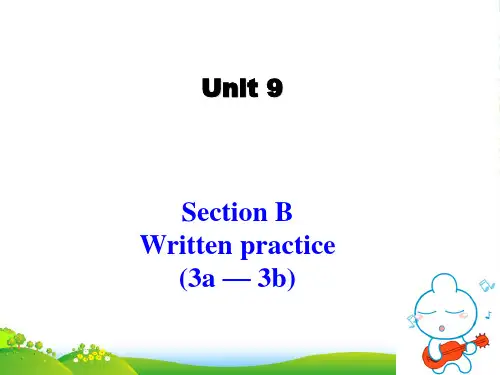
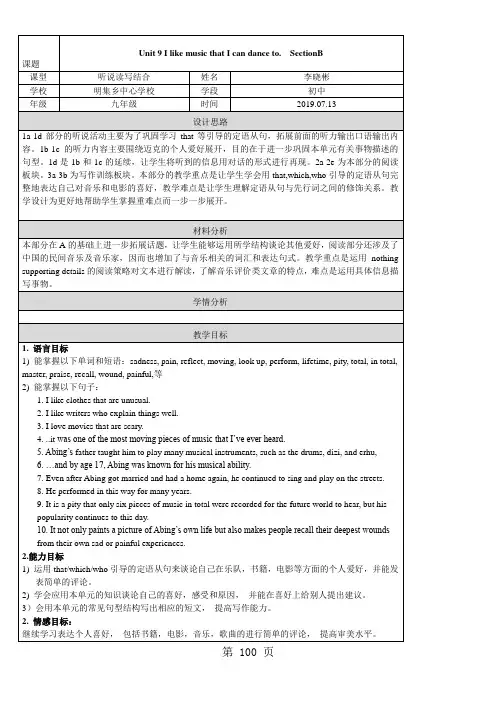

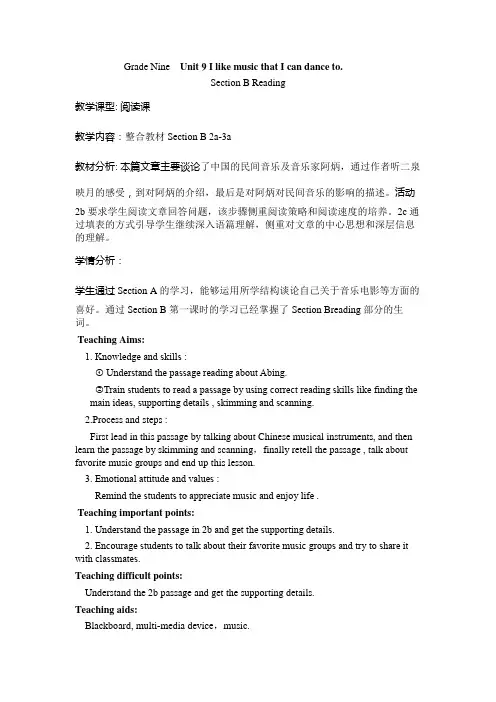
Grade Nine Unit 9 I like music that I can dance to.Section B Reading教学课型: 阅读课教学内容:整合教材Section B 2a-3a教材分析: 本篇文章主要谈论了中国的民间音乐及音乐家阿炳,通过作者听二泉映月的感受,到对阿炳的介绍,最后是对阿炳对民间音乐的影响的描述。
活动2b要求学生阅读文章回答问题,该步骤侧重阅读策略和阅读速度的培养。
2c通过填表的方式引导学生继续深入语篇理解,侧重对文章的中心思想和深层信息的理解。
学情分析:学生通过Section A 的学习,能够运用所学结构谈论自己关于音乐电影等方面的喜好。
通过Section B第一课时的学习已经掌握了Section Breading部分的生词。
Teaching Aims:1. Knowledge and skills :① Understand the passage reading about Abing.②Train students to read a passage by using correct reading skills like finding themain ideas, supporting details , skimming and scanning.2.Process and steps :First lead in this passage by talking about Chinese musical instruments, and then learn the passage by skimming and scanning,finally retell the passage , talk about favorite music groups and end up this lesson.3. Emotional attitude and values :Remind the students to appreciate music and enjoy life .Teaching important points:1. Understand the passage in 2b and get the supporting details.2. Encourage students to talk about their favorite music groups and try to share it with classmates.Teaching difficult points:Understand the 2b passage and get the supporting details.Teaching aids:Blackboard, multi-media device,music.Teaching procedures:Step1 Leading in ( Free talk)1. Teacher asks :“Do you like music ? Do you like Chinese folk music?”Step2 Pre-reading ( 2a )1.T : How many Chinese musical instruments do you know about ?Learn some Chinese musical instruments.2. Listen to Erquan Yingyue and answer.Q: What is the name of this piece of music ?Q: What is your feeling about this song ?Step3 While-reading1、Fast reading : Skimming (2b)Students read paragraph 1、2 and 3 quickly and try to answer some questions.Q1: What is the writer ' s feeling about this song ?Q2: Who wrote this song?Q3: What is the name of Abing's most famous piece of music?Q4: Which musician does the reading passage mainly talk about ?Learn the introduction of Abing.2、Careful reading: Scanning (2c)(1). Students read the article and use suitable words to complete the main idea of each paragraph. Then list the supporting details in each paragraph.(2). While reading, predict some important words.(3). Complete 2d. Fill in the blanks with the words in the box.Step4 Post-readingAccording to the small pictures and blanks retell the story about Abing .Step5 Group workTalk about students’ favorite music and then perform it.Teacher : Nothing is worth living for without music. -----NietzscheStep6 HomeworkWrite a short passage about your favorite music : Use the following expressions to help you :1、My favorite music is ......2、I like ......because......3、This song was sang by ....4、Do you know more about the singer ?。
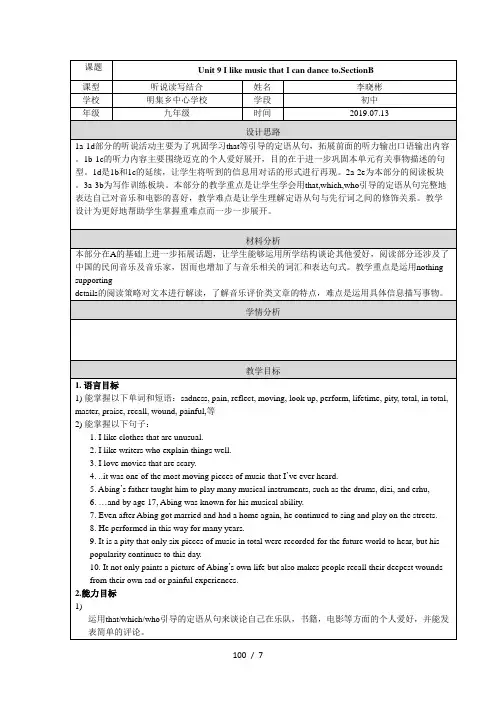
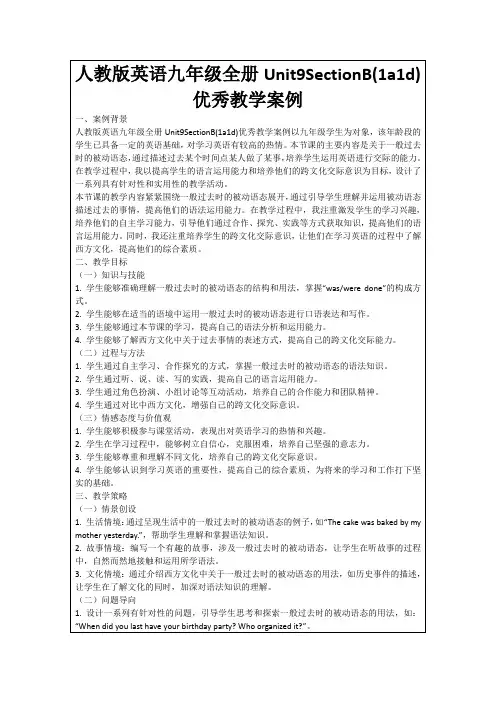
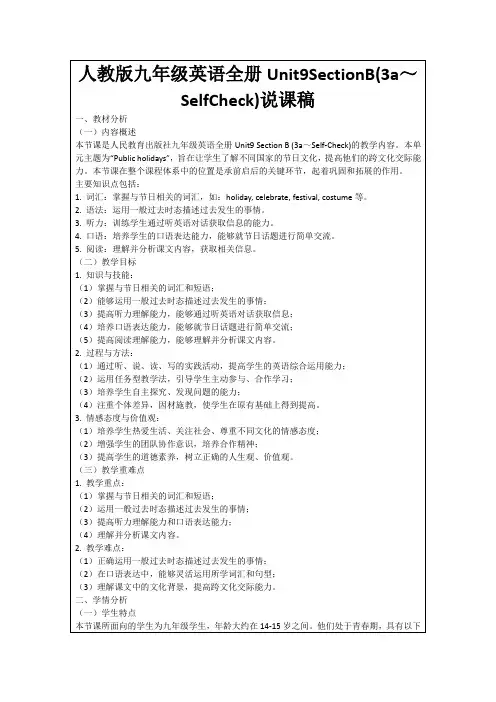

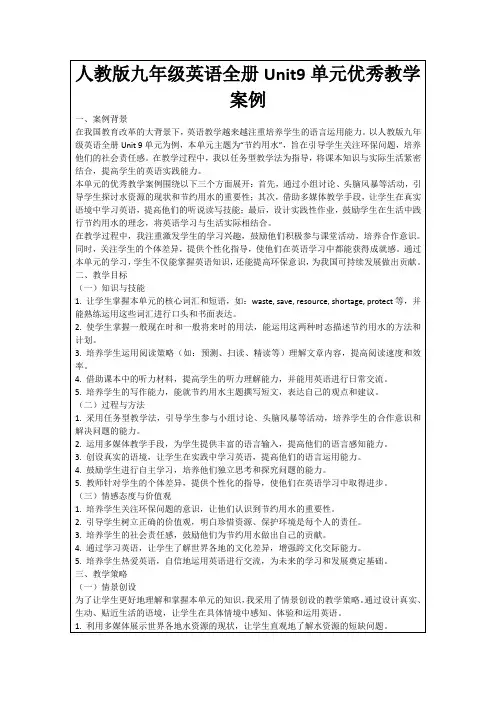
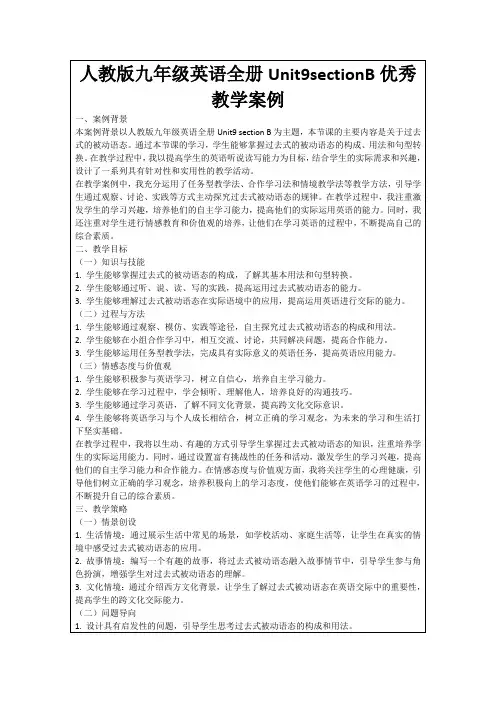
人教版初中九年级英语Unit9 SectionB(3a-3b)优质课教案Ⅰ.Studying Aims (学习目标):1. Knowledge ObjectivesReview SectionB 2b and learn key sentences. My favorite kind of music is (I)like … because … It was … by …When I listen to /watch it, I feel …I think you should listen to / watch it to because …2. Ability objective:(1) Listen to the teacher’s story and fill the blanks.(2) Ask and answer the questions about the story of the teacher.(3) Read the model articles.(4) Write articles about the students’ favorite music, movies etc.3. Moral objectives:Learn to love better lives and show the love of the Chinese traditional culture.3. Key Points and DifficultyKey Points:Master the vocabularies, phrases and useful expressions about music.Difficulty:Use the useful expressions to describe their favorite.II. Teaching Methods and Learning Strategies(1) Communicative teaching method, task-based language teaching and situational teaching method.(2) Working in groups and self-directed learning, evaluation learningIII. Teaching AidsMultimedia show: recordings, pictures, videoIV. Teaching proceduresStep 1 Warming up and lead in the new lesson.1.学生和教师跟随《英文版小苹果》合唱跳舞。
Unit9 SectionB(3a-3b)优质课教案
Ⅰ.Studying Aims (学习目标):
1. Knowledge Objectives
Review SectionB 2b and learn key sentences. My favorite kind of music is (I)
like … because … It was … by …
When I listen to /watch it, I feel …
I think you should listen to / watch it to because …
2. Ability objective:
(1) Listen to the teacher’s story and fill the blanks.
(2) Ask and answer the questions about the story of the teacher.
(3) Read the model articles.
(4) Write articles about the students’ favorite music, movies etc.
3. Moral objectives:
Learn to love better lives and show the love of the Chinese traditional culture.
3. Key Points and Difficulty
Key Points:
Master the vocabularies, phrases and useful expressions about music.
Difficulty:
Use the useful expressions to describe their favorite.
II. Teaching Methods and Learning Strategies
(1) Communicative teaching method, task-based language teaching and situational teaching method.
(2) Working in groups and self-directed learning, evaluation learning
III. Teaching Aids
Multimedia show: recordings, pictures, video
IV. Teaching procedures
Step 1 Warming up and lead in the new lesson.
1.学生和教师跟随《英文版小苹果》合唱跳舞。
2.复习描述音乐的句型。
教师问学生随音乐跳舞的感受和对该音乐的感受。
T: How do you feel now? Do you like Little Apple? What’s your favorite music?
What kind of music do you like?
Step 2 Show the rule of evaluation
用参与宜昌音乐会需要票,引入介绍评价规则。
每回答老师一个问题就得到一张音乐图片。
然后将图片贴在表格中,完成表格英语字母构成的3个组成员每人会得到一张音乐票。
Step 3 Check listening
T: Let’s start our music journey. The first stop is Checking your listening. Listen to Miss Zeng’s story of music and fill in the blanks. Then check it in groups and show the answers. The teacher gives the pictures to the student whose answers are right. Step 4 Speaking practice
关于My Story about a concert of Erquan Yinyue .(复习2b课文)然后教师让学生分小组问关于故事的一些问题。
复习描述音乐的句型。
小组长扮演老师的角色。
然后选一组展示,教师在黑板上完成自己的作文。
Step 5 Learning
展示TFboys乐队,提升范文,让学生还原句子介绍喜欢的音乐。
My favorite kind of music is .
I like it because .
It was by TF boys.
When I listen to it, I feel . I think you should listen to it, too.
Because .
然后播放TFboys的歌曲,让学生听后,问是否喜欢。
加上文字的开头和结尾。
帮助学生分析文章结构。
文章有开头、主体和结尾三部分构成。
Step 6 Practice and reading
学生根据我讲的文章分析方法,分析教师关于音乐会的描述文章的结构。
标上序号。
再次巩固文章写法。
并朗读。
Step 7 Writing Practice
分7个小组分别谈论喜欢的书、动画、电影、电话、节日、发明。
然后独自写作文:我最喜爱的_______
Step 7 Show time。